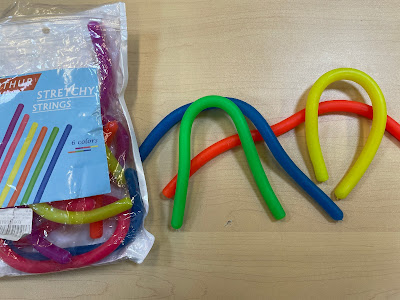Song: Bouncy Bouncy Bouncy
Vocabulary and Basic Concepts: experiment, bounce/-ing/-ed, yes/no, do/do not, high/low, 1-2-3, drop, roll/-ing/-ed, fast/slow, me/my/mine, He/She, His/Hers, Who/What/Where, my turn, predict.
Miss Carrie said we were going to try an experiment. An experiment is when we try something to see what happens. Last week, we experimented with bouncing balls. But, do other things bounce?
Hmmmm......
First, we tried stretch strings. We held them up high, counted together "1-2-3-DROP!" Everyone dropped it at the sane time. What happened? Did it bounce? No, they didn't bounce. They just stayed there on the floor. We tried it again to be sure. "1-2-3-DROP!" Hmmm. Stretchy strings do not bounce.
We tried dinosaurs. "1-2-3-DROP!" What happened? Did they bounce? No, they kind of rolled. Dinosaurs do not bounce. We tried it twice to be sure.
We tried bean bag animals. "1-2-3-DROP!" What happened? Did they bounce? One child responded that her frog flopped. We tried twice. No, bean bag animals do not bounce.
We experimented with blocks. Some of the kids noted that blocks are square. Maybe these will bounce? "1-2-3-DROP!" What happened? Some said their block bounced a little bit. Others said their blocks rolled. We determined that blocks do not bounce. At least, they don't bounce like balls.
What if we experiment with something round? These cotton snowballs are round. They look like balls. Will these bounce? "1-2-3-DROP!" They bounced! Not nearly as much as a bouncy ball. One child said that these were too hard to catch. So our pretend snow balls do bounce. At least a little bit.
Last, Miss Carrie reviewed what items we experimented with. Stretchy strings, dinosaurs, bean bags, blocks, and balls. There was one more thing we didn't try.
DO KIDS BOUNCE?
As soon as Miss Carrie asked this questions, no one needed more instruction. Every child started bouncing.
YES, KIDS DO BOUNCE!
Do this at home: try your own science experiments.
During bath time, you could determine DOES IT FLOAT?
During a walk, why not experiment with DOES IT HAVE EYES? (Be on the look out!)
Playing on the floor with your child, pull out some toys to shake or rattle. DOES IT MAKE NOISE?
During a family meal: DOES IT CRUNCH? (yes, this requires everyone to chew with their mouth open. We try this experiment during Snack Time as well.)


























